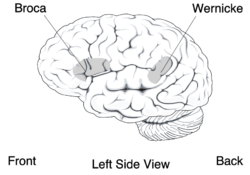Planum temporale
| Planum temporale | |
|---|---|

Approximate location of Wernicke's area highlighted in gray
|
|
| Identifiers | |
| NeuroNames | ancil-432 |
| Dorlands /Elsevier |
p_22/12644657 |
|
Anatomical terms of neuroanatomy
[]
|
|
The planum temporale is the cortical area just posterior to the auditory cortex (Heschl's gyrus) within the Sylvian fissure. It is a triangular region which forms the heart of Wernicke's area, one of the most important functional areas for language. Original studies on this area found that the planum temporale was one of the most asymmetric regions in the brain, with this area being up to ten times larger in the left cerebral hemisphere than the right.
The planum temporale makes up the superior surface of the superior temporal gyrus to the parietal lobe. The posterior extent of the planum temporale has been variably defined, which has led to disputes to estimates of size and degree of asymmetry.
The planum temporale shows a significant asymmetry. In 65% of all individuals the left planum temporale appears to be more developed, while the right planum temporale is more developed in only 11%. In some people’s brains, the planum temporale is more than five times larger on the left than on the right, making it the most asymmetrical structure in the brain. Evidence for this asymmetry has also been seen in great apes.
This greater size of the left planum temporale compared with the right is already present in the fetus, where it can be observed starting from the 31st week of gestation. This observation strengthens the hypothesis of a genetic predisposition for brain asymmetry, however the effect of fetal experience has not been ruled out. Leftward asymmetry, however, does not directly relate to asymmetry of language processing in all individuals.
In addition, more and more research is suggesting that the apparent asymmetries in this region are the result of old techniques and criteria used to identify the planum temporale. When new imaging is used that takes into account asymmetries in the curvatures of lateral fissures, the hemispheric asymmetries of the planum temporale become negligible. This newer imaging would indicate that the size of the region would not explain the higher faculties of language in the left hemisphere, but would instead require an analysis of the neural circuitry.
The planum temporale is a highly lateralized brain structure involved with language and with music. Although the planum temporale is found to have an asymmetry in the normal population, having a leftward bias in right-handed individuals, people who possess absolute pitch have an increased leftward asymmetry of the planum temporale. This is due to a smaller than average volume of the right planum temporale and not a larger than average volume of the left. The planum temporale may also play an important role in auditory processing with recent research suggesting that the region is responsible for representing the location of sounds in space.
...
Wikipedia
